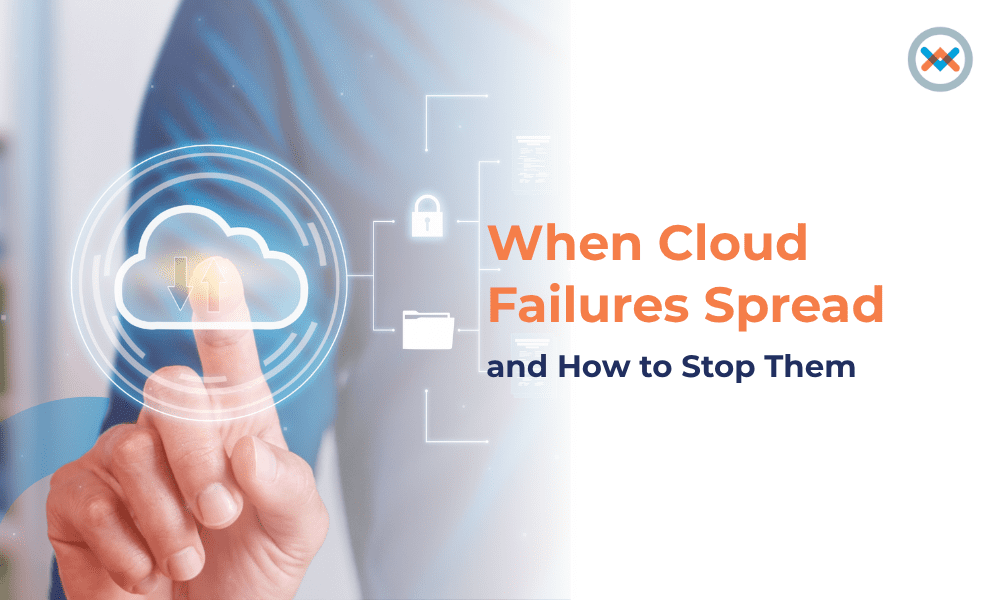In 2021, Facebook, Instagram, and WhatsApp went offline for hours after a simple configuration mistake. That small issue snowballed into a global outage — DNS failed, data centers went dark, and even internal tools went offline. The result? Millions lost, and users questioning reliability.
This case shows how, in the cloud, small problems rarely stay small. One overlooked setting or dependency can trigger a chain reaction that takes multiple systems down.
Understanding the Blast Radius
Think of your cloud as a network of dominos. Each service, database, and application standing tall, ready to support the next. When one domino falls, others connected to it tumble too. Engineers call that chain of impact the blast radius.
The blast radius measures how far the impact spreads when a failure occurs. This includes how many systems go down, how many customers are affected, and how long it takes to recover.
In highly connected architectures, the blast radius grows quickly. If your DNS is centralized, a single misconfiguration can make every endpoint unreachable. If your storage and compute share the same region, a local outage can halt all operations. Even automation tools can make things worse when a faulty script quickly applies the wrong settings to every instance.
Reducing the blast radius isn’t about avoiding every problem. It’s about designing your systems so any impact stays contained. Resilient systems don’t aim for perfection. They aim for isolation, visibility, and control.
Designing for Containment
Containment is the foundation of cloud resilience. The goal is simple: when something breaks, it breaks alone. Below are key strategies to keep problems small and recovery quick.
Segment by Function and Region
Separate environments based on function (production, staging, development) and location.
That way, if one area goes down, the rest stay up.
For example, don’t host your critical production workloads and testing environments in the same region. Keep credentials, storage buckets, and routing configurations distinct. Segmentation helps contain a localized fault and prevents it from spreading across zones or environments.
In multi-region setups, cross-replication ensures that if one region experiences latency or failure, traffic automatically reroutes to healthy zones. Your users may notice a brief delay, but not a total outage.
Build Redundancy into Every Layer
Think of redundancy as your system’s safety net — not waste, but protection.
If one part fails, another instantly takes over. That’s why resilient architectures:
- Spread workloads across providers and regions.
- Keep data mirrored and updated.
- Rely on auto-scaling to handle sudden traffic or failure.
This safety net adds cost, but it's the cheapest insurance you’ll ever buy.
Maintain Load-Balancer Hygiene
Load balancers distribute traffic efficiently, but when misconfigured, they can magnify downtime. That is why you should keep balancing rules, routing tables, and health checks updated. Ensure each node reports status accurately and that failover routes are validated regularly.
An untested or outdated setup can trigger a chain of failures, especially during traffic spikes. Treat load balancers as living systems — monitor, test, and update them regularly.
Map and Visualize Dependencies
You can’t protect what you can’t see. Many cascading failures happen because teams underestimate just how tightly connected their systems really are. Here’s how to prevent that:
- Create a complete dependency map. Include all key components, including databases, APIs, authentication systems, and third-party services.
- Use monitoring tools that show relationships. Visualization helps you understand how one failure might affect others.
- Identify weak links early. With clear visibility, you can respond faster when issues appear.
- Review before changes. When modifying or decommissioning a system, check which other services rely on it to avoid unintended disruption.
Test Failover Scenarios Regularly
Failover setups only matter if they work under pressure. Don’t wait for a real outage to find out. Here’s how to prepare:
- Simulate real-world failures. Test what happens if a region or data center goes offline.
- Check API and latency behavior. Slow down or temporarily disconnect certain services to see how your systems react.
- Observe recovery flow. Make sure workloads shift automatically and alerts trigger as expected.
- Train your teams. Use drills to practice communication and coordination during downtime.
Testing for Readiness
Resilience isn’t built in a crisis— it’s built through repetition. Regular testing helps teams and systems stay calm, clear, and coordinated when things go wrong. Here’s how to build true readiness:
Run Regular Drills
Simulate outages or slowdowns to see how systems and teams respond in real time.
Measure What Matters
Track key metrics like recovery time, alert accuracy, and communication speed.
Involve Everyone
Readiness isn’t just an IT job. Operations, management, and support teams should all know their roles during disruptions.
Use Visibility Tools
Keep observability dashboards that monitor networks, applications, and user experience, not just to detect problems, but to anticipate them.
Review and Improve
After each drill, document what worked and what didn’t. Turn every test into an improvement plan.
Readiness Is True Resilience
Every cloud system will fail at some point. The question is not if, but how far the failure spreads and how fast you recover.
A truly resilient business isn’t the one that never goes down, it’s the one that gets back up fast, stays transparent, and keeps customer trust intact.
Reducing blast radius, building redundancy, and testing for containment are all parts of the same philosophy: Resilience begins with readiness, not luck.
Talk to Wowrack today to assess your cloud readiness and containment strategy. Together, we’ll build infrastructure that bends, not breaks— so the next time a failure hits, it ends where it starts.







